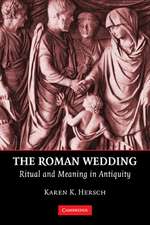Performance, Memory, and Processions in Ancient Rome: The Pompa Circensis from the Late Republic to Late Antiquity
Autor Jacob A. Lathamen Limba Engleză Paperback – 29 ian 2020
| Toate formatele și edițiile | Preț | Express |
|---|---|---|
| Paperback (1) | 326.92 lei 43-57 zile | |
| Cambridge University Press – 29 ian 2020 | 326.92 lei 43-57 zile | |
| Hardback (1) | 778.22 lei 43-57 zile | |
| Cambridge University Press – 15 aug 2016 | 778.22 lei 43-57 zile |
Preț: 326.92 lei
Nou
Puncte Express: 490
Preț estimativ în valută:
62.58€ • 67.99$ • 52.60£
62.58€ • 67.99$ • 52.60£
Carte tipărită la comandă
Livrare economică 21 aprilie-05 mai
Preluare comenzi: 021 569.72.76
Specificații
ISBN-13: 9781107576667
ISBN-10: 1107576660
Pagini: 367
Ilustrații: 86 b/w illus.
Dimensiuni: 176 x 254 x 20 mm
Greutate: 0.64 kg
Editura: Cambridge University Press
Colecția Cambridge University Press
Locul publicării:New York, United States
ISBN-10: 1107576660
Pagini: 367
Ilustrații: 86 b/w illus.
Dimensiuni: 176 x 254 x 20 mm
Greutate: 0.64 kg
Editura: Cambridge University Press
Colecția Cambridge University Press
Locul publicării:New York, United States
Cuprins
Dedication; Acknowledgements; List of illustrations; Abbreviations; Introduction: 1. History in the subjunctive; 2. Idioms of spectacle between Hellenism and Imperialism; 3. Ritual rhythms of the pompa circensis; Part I. An Ideal-type between the Republic and Memories of the Republic: 1. Pompa hominum: gravity and levity, resonance and wonder, ritual failure; 1.1 'Rituals in ink': Dionysius of Halicarnassus; 1.2 Gravity, levity, and ritual resonance in the pompa hominum; 1.2.1 'Those holding the greatest authority'; 1.2.2 '[Roman] sons on the verge of manhood'; 1.2.3 'The charioteers followed'; 1.2.4 'Numerous companies of dancers'; 1.2.5 'Bands of dancers playing satyrs'; 1.2.6 'Censers in which incense and frankincense were burned'; 1.3 Wonder: spectacle and the pompa circensis; 1.4 Ritual failure in the pompa hominum; 2. Pompa deorum: performing theology, performing the gods; 2.1 Religious education and performed 'theology'; 2.2 Performing the gods; 2.2.1 Fercula and simulacra; 2.2.2 Exuviae and tensae; 2.2.3 Folkloric figures; 2.3 Regulations, risks, and ritual failure in the pompa deorum; 3. Iter pompae circensis: memory, resonance, the image of the city; 3.1 An itinerary of collective memory; 3.2 Resonance and repetition; 3.2.1 Capitolium: 'the citadel and Capitolium, the seat of the gods, the senate, and the head of public judgment'; 3.3.2 Forum Romanum: 'wider intercolumniations should be distributed around the spectacles… and in balconies should be placed in the upper stories'; 3.2.3 Velabrum: 'the vile throng of the vicus Tuscus'; 3.2.4 Aedes Cereris; 3.2.5 Circus Maximus: 'they come to see, they come that they may be seen'; 3.3 Imaging Rome on the ground and in the imagination; 3.3.1 Way-finding in Republican Rome; 3.3.2 Symbolic cityscapes: Senatus populusque Romanus et dei and Aurea Roma; 3.4 An ideal-type between the Republic and memories of the Republic; Part II. The Pompa Circensis from Julius Caesar to Late Antiquity: 4. 'Honors greater than human': Imperial cult and the pompa circensis; 4.1 Imperial gods in the pompa circensis: from Caesar to the Severans; 4.1.1 Dynastic beginnings: Caesar to Augustus; 4.1.2 The Augustan settlement: honoring divus Augustus; 4.1.3 Innovation into tradition: the Julio-Claudians; 4.1.4 Divi, divae, and the imperial family from the Flavians to the Severans; 4.1.5 The traditional gods; 4.2 An imperial palimpsest: the itinerary from Augustus to Septimius Severus; 4.2.1 Restoring cultural memory in Imperial Rome; 4.2.2 Deus Praesens: Imperial cult temples and triumphal arches; 5. Behind 'the Veil of power': ritual failure, ordinary humans, and Ludic processions during the High Empire; 5.1 Imperial ritual failure; 5.2 'Ordinary' humans in the pompa circensis; 5.3 The pompa circensis outside Rome and the pompa (amphi-)theatralis; 5.3.1 The pompa circensis outside Rome; 5.3.2 The pompa (amphi-)theatralis; 5.4 'The horses, fleet as the wind, will contend for the first palm'; 6. The pompa circensis in Late Antiquity: imperialization, Christianization, restoration; 6.1 Pompa diaboli: Christian rhetoric and the pompa circensis; 6.2 Voluptates: imperial law and the 'secularization' of the ludi; 6.3 Emperors and victory: the pompa circensis in Late Antiquity; 6.4 The sub-imperial pompa circensis in Late Antiquity; 6.5 Restoring the 'Republic': the Late Antique itinerary; Conclusion; Bibliography; Index.
Notă biografică
Descriere
Jacob A. Latham explores the play between performance and itinerary, tracing the transformations of the circus procession through Rome's history.















